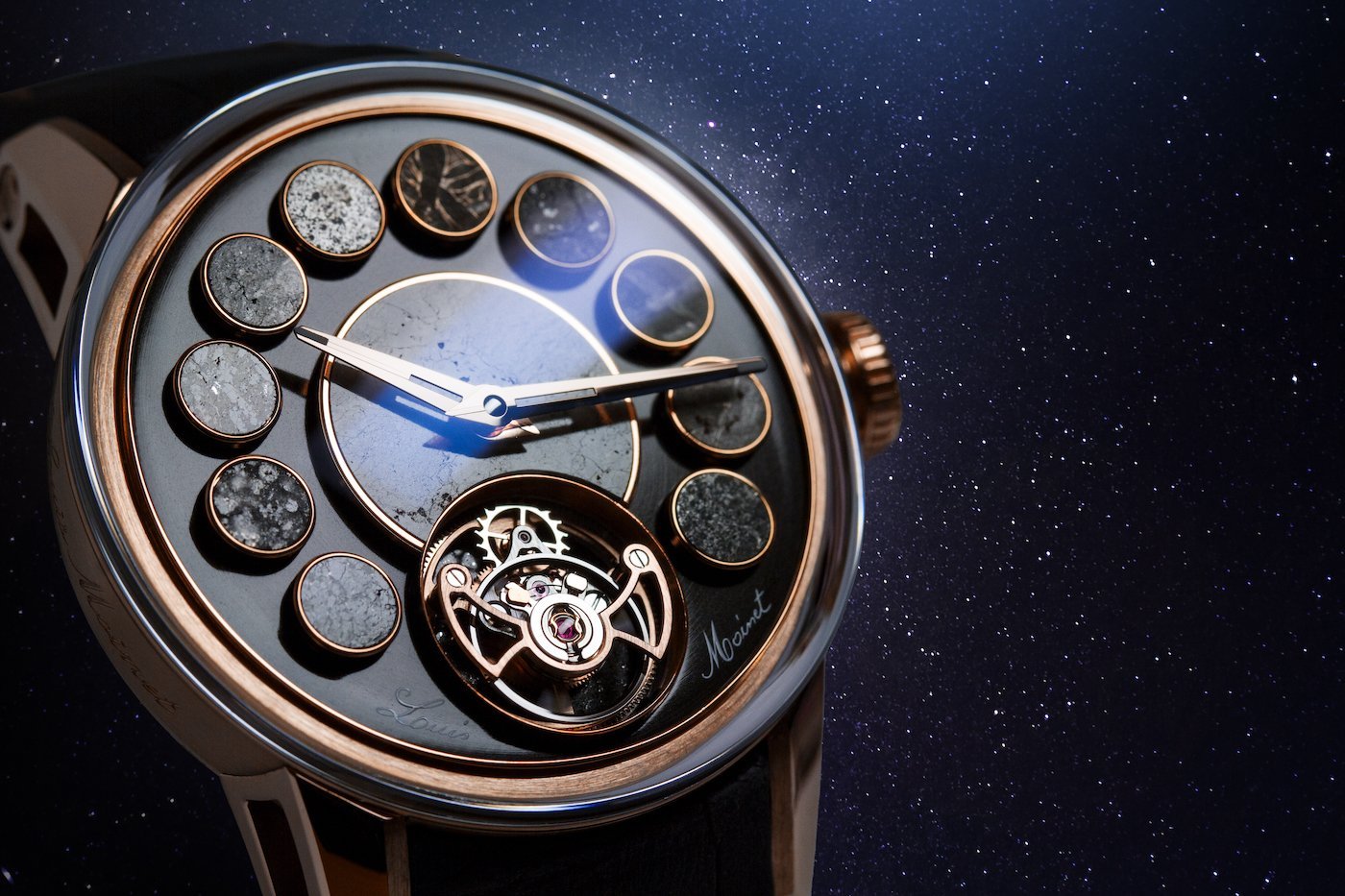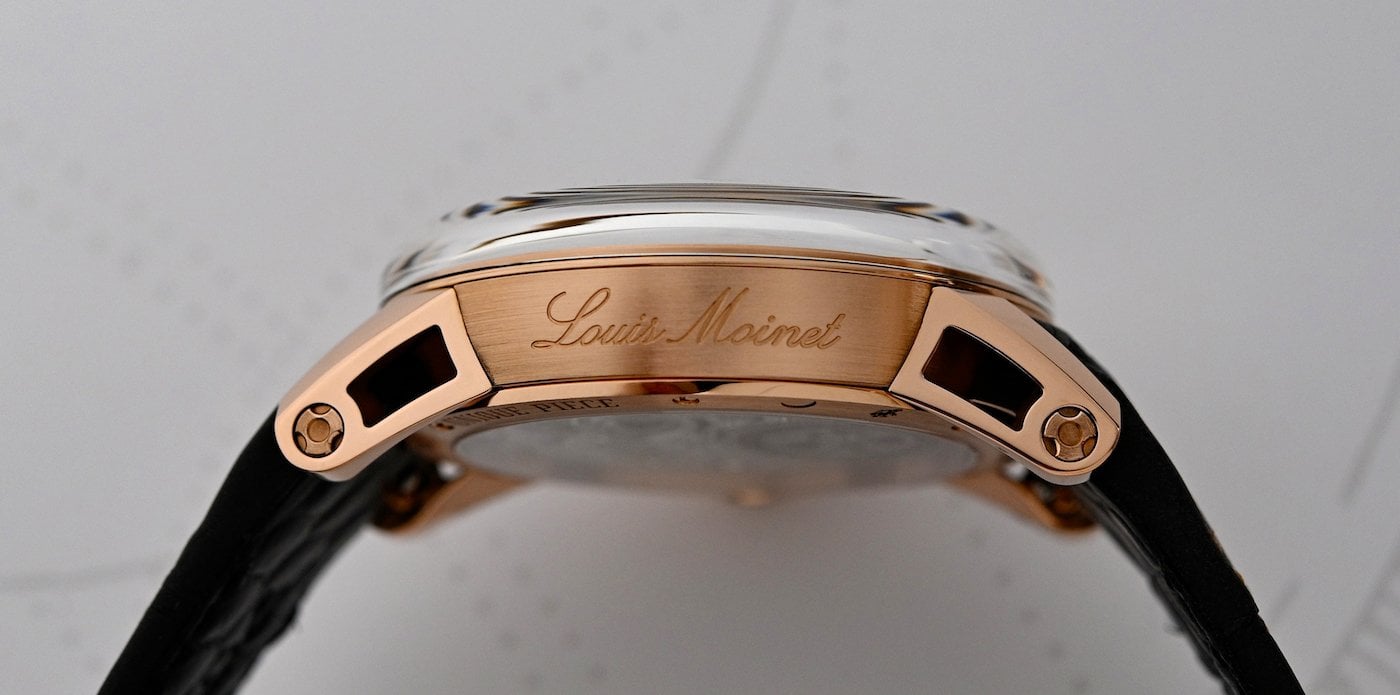eteorites represent the origin of the universe. There is a form of purity in these fragments which I find deeply moving,” confides Jean-Marie Schaller, CEO and creative director of Louis Moinet. Cosmopolis, his latest creation, is a reflection on the origin of the universe and our place within time, but also connects with the brand’s history.
“The first spark came from the story of Louis Moinet himself,” Schaller explains. “Micaela [Bartolucci, his wife] and I set out on the adventure that would become the Louis Moinet brand 25 years ago. We were intrigued by a man who had been consigned to oblivion yet an eight-page obituary by one of his friends, the one remaining trace, described him as the greatest watchmaker of all. I did some research and found out that he had invented the chronograph and high frequency, and that his timepieces were owned by some of the most important personalities of his day. His three passions in life were art, astronomy and horology, and it would be this interest in astronomy that inspired us to incorporate meteorites into Louis Moinet watches.”
Before any talk of meteorites, and a closer look at the Cosmopolis, let’s come back to these two assertions, that Louis Moinet is the inventor of the chronograph and high frequency. The general consensus among historians of time measurement was that the chronograph had been invented in 1822 by Nicolas Rieussec, who built a device that used ink to record elapsed intervals. Until an extraordinary timepiece surfaced in 2013 that challenged all previous assumptions. The first true chronograph, it measures 1/60th of a second by means of a central hand.
-

- Louis Moinet’s compteur de tierces
Built between 1815 and 1816, this pocket watch is signed Louis Moinet on its dial. Moinet called it a compteur de tierces, “tiers” being the name given to 1/60th of a second. In order to achieve such precision, Moinet’s chronograph oscillates at 30 Hz, a frequency that would only be mastered in watchmaking some two centuries later...

The vast majority of mechanical watches run at a frequency of 4 Hz or 28,800 vibrations per hour. In 2017 Zenith launched the Defy El Primero 21, equipped with two separate movements. One, for the hours and minutes, beats at 36,000 vibrations per hour or 5 Hz, which is the frequency of the famed El Primero calibre. The other is for the chronograph function, which measures 1/100th of a second. It operates for just 50 minutes on a full wind and its balance oscillates at 360,000 vibrations per hour or 50 Hz. Louis Moinet devised his compteur de tierces to track the movements of the stars. By equipping it with a balance oscillating at 30 Hz, he was two centuries ahead of his time.
Jean-Marie Schaller’s decision to put twelve meteorites on the Cosmopolis’s dial wasn’t motivated by opportunism. For the past twenty years, he has been building a collection, which he sources from meteorite hunter and dealer Luc Labenne (read about him here). “The first specimen I bought from Luc was a lunar meteorite. It moved me to tears. You look at the Moon and you tell yourself it’s 360,000 kilometres away and you’re holding a piece of it in your hand.” This fascination with meteorites comes from their rarity but also their beauty. “Have you ever seen pallasite [a meteorite composed of olivine crystals in a ferrous matrix]?” he asks. “It’s magnificent, as though a creator took a piece of raw material and turned it into art.”
Schaller likens the process to “creating a planetary system inside the watch.” Each fragment was entrusted to Daniel Haas, a specialist in semi-precious stones, to be cut.
The Cosmopolis was designed by Jean-Marie’s son, Nathanaël Schaller. “The main challenge was to include as many varieties of meteorite as possible, and to arrange them in a visually attractive way,” he says. There are twelve meteorites and twelve hours. Each space between the meteorites represents an hour marker, up to the tourbillon. We’ve included a piece of black chondrite behind the tourbillon cage and a lunar meteorite in the centre, because who hasn’t gazed up at the Moon in wonder. I wanted the end result to be harmonious. I trained as a jeweller and all the meteorites are in a closed setting. You can almost imagine them as specimens in a museum.” The watch has been awarded the Guinness World Records™ title for the "Most meteorite inserts in a watch”.
Among guests at the launch evening was Luc Labenne, who shared precious information on some of the rare fragments on the Cosmopolis’s dial. “Every one of these twelve meteorites has a different story,” he says. “There’s one from Mars, another from the Moon and also a particular favourite of mine, called Erg Chech 002, which is the oldest rock in our solar system. When I first saw the photos sent by the people who discovered it, I wasn’t entirely sure it was a meteorite, because of the unusual large green crystals. The scientists who analysed it not only confirmed that it was a meteorite, they were able to date it as the oldest known.” At 4.567 billion years old, Erg Chech 002 is a fragment of protoplanet that predates Earth itself.
SThe Cosmopolis also includes a fragment of Allende, a meteorite that fell over Mexico. “This one has inclusions which occurred during the early formation of the solar system, although Erg Chech beats it in terms of age. Then there’s Aguas Zarcas, a fascinating meteorite which fell over Costa Rica. It contains amino acids and is one of the few to contain around 15% water. Scientists believe that around 20% of the water on Earth could have been transported by this type of meteorite, which were abundant at the beginning of the solar system. And I forgot to mention the Sahara 97093 which contains micro-diamonds, measuring between 20 and 100 microns, which formed during the explosion of supernovas, which are rich in carbon. The Cosmopolis brings together many legendary meteorites.”
Listening to this meteorite hunter describing each of the specimens on the Cosmopolis’s dial leaves no doubt that this unique watch really does contain a little piece of the solar system’s history.


























































